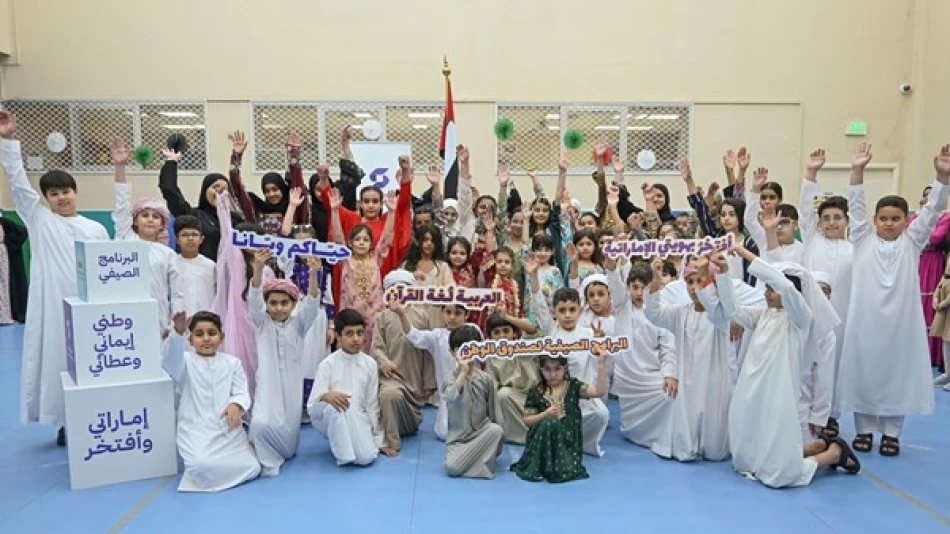
Summer Programs of 'Homeland Fund' Uncover Talents, Empower National Identity
UAE's Al Watan Fund Transforms Summer Break Into National Identity Laboratory
The UAE is conducting one of the region's most ambitious cultural preservation experiments through Al Watan Fund's summer programs, which have evolved beyond traditional youth activities into a sophisticated platform for strengthening Emirati identity while fostering innovation. With 93 institutional partners and operations across 56 locations nationwide, the initiative represents a strategic response to globalization's cultural challenges facing Gulf states.
Strategic Investment in Cultural Continuity
Sheikh Nahyan bin Mubarak Al Nahyan, Minister of Tolerance and Coexistence and Chairman of Al Watan Fund's Board of Directors, positioned these programs as more than summer entertainment. The initiative operates on two fundamental pillars: reinforcing national identity among new generations while promoting Arabic as "the language of the Holy Quran," and implementing community-focused activities aligned with the UAE's designated "Year of Community."
This approach reflects a broader Gulf trend where traditional monarchies are investing heavily in cultural programming to maintain social cohesion amid rapid modernization. Unlike Saudi Arabia's Vision 2030 entertainment focus or Qatar's cultural diplomacy through mega-events, the UAE is betting on grassroots identity formation among school-age populations.
The Arabic Language as Cultural Anchor
The third week of programming, themed "Arabic: Language of the Quran," demonstrates the UAE's calculated approach to cultural preservation. Students engage with selected Quranic verses containing universal human values while exploring Arabic's literary and artistic dimensions through calligraphy workshops and creative writing exercises.
Innovation Meets Tradition
What distinguishes this program from typical cultural initiatives is its integration of artificial intelligence training alongside traditional Arabic instruction. Students create short stories, compose letters, produce visual art, and develop AI applications—all while strengthening their Arabic language skills and Quranic understanding.
This dual focus addresses a critical challenge facing Arab nations: maintaining linguistic and religious heritage while preparing youth for technology-driven economies. The UAE's approach suggests that cultural authenticity and technological advancement need not be mutually exclusive.
Institutional Ecosystem and Scale
General Manager Yasser Al Qarqawi highlighted the program's remarkable institutional buy-in, with 93 partners spanning government schools, private institutions, cultural centers, and youth facilities. This level of coordination indicates serious governmental commitment and suggests the program has moved beyond pilot phase into systematic implementation.
The geographic spread across all seven emirates ensures rural and urban students receive equal exposure, addressing a common criticism of UAE development programs that concentrate benefits in Dubai and Abu Dhabi.
Measuring Cultural Impact
Early indicators suggest measurable outcomes beyond participation numbers. School administrators report increased student confidence in Arabic expression, reduced hesitation in using formal Arabic, and stronger identification with Emirati values. International trainer Intisar Issa noted particularly strong engagement among students over twelve, indicating the program successfully reaches adolescents typically resistant to cultural programming.
Community Volunteer Integration
The program's community service component creates tangible local benefits while instilling civic responsibility. Students execute volunteer projects serving both school and broader community needs, creating visible connections between cultural learning and social contribution.
Regional Context and Strategic Implications
This initiative emerges as Gulf states grapple with demographic realities—expatriate populations often outnumber nationals, and global cultural influences compete with traditional values. The UAE's response through systematic youth programming contrasts with purely regulatory approaches seen elsewhere in the region.
The program's emphasis on Arabic language proficiency also supports the UAE's broader economic diversification goals. As the country positions itself as a regional hub for technology, finance, and culture, maintaining Arabic as a living language rather than ceremonial relic becomes economically strategic.
Sustainability and Future Expansion
The program's success metrics will likely influence similar initiatives across the Gulf Cooperation Council. If the UAE demonstrates that intensive cultural programming can strengthen national identity without hindering modernization, other Gulf states may adopt comparable approaches.
The integration of AI training within cultural education also positions participating students advantageously for the UAE's knowledge economy transition. This practical benefit may prove crucial for maintaining program support among pragmatic parents prioritizing their children's economic prospects.
The real test will come as these students mature and face career decisions. Whether this cultural foundation translates into sustained Arabic usage, religious engagement, and civic participation will determine if the UAE has found a scalable solution to modernity's cultural challenges—or simply created an elaborate summer program.
 Layla Al Mansoori
Layla Al Mansoori







